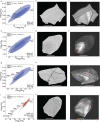Hadaean to Palaeoarchaean stagnant-lid tectonics revealed by zircon magnetism
- PMID: 37316722
- PMCID: PMC10266976
- DOI: 10.1038/s41586-023-06024-5
Hadaean to Palaeoarchaean stagnant-lid tectonics revealed by zircon magnetism
Abstract
Plate tectonics is a fundamental factor in the sustained habitability of Earth, but its time of onset is unknown, with ages ranging from the Hadaean to Proterozoic eons1-3. Plate motion is a key diagnostic to distinguish between plate and stagnant-lid tectonics, but palaeomagnetic tests have been thwarted because the planet's oldest extant rocks have been metamorphosed and/or deformed4. Herein, we report palaeointensity data from Hadaean-age to Mesoarchaean-age single detrital zircons bearing primary magnetite inclusions from the Barberton Greenstone Belt of South Africa5. These reveal a pattern of palaeointensities from the Eoarchaean (about 3.9 billion years ago (Ga)) to Mesoarchaean (about 3.3 Ga) eras that is nearly identical to that defined by primary magnetizations from the Jack Hills (JH; Western Australia)6,7, further demonstrating the recording fidelity of select detrital zircons. Moreover, palaeofield values are nearly constant between about 3.9 Ga and about 3.4 Ga. This indicates unvarying latitudes, an observation distinct from plate tectonics of the past 600 million years (Myr) but predicted by stagnant-lid convection. If life originated by the Eoarchaean8, and persisted to the occurrence of stromatolites half a billion years later9, it did so when Earth was in a stagnant-lid regime, without plate-tectonics-driven geochemical cycling.
© 2023. The Author(s).
Conflict of interest statement
The authors declare no competing interests.
Figures










Similar articles
-
Earth's magnetic field and its relationship to the origin of life, evolution and planetary habitability.Natl Sci Rev. 2025 Mar 3;12(5):nwaf082. doi: 10.1093/nsr/nwaf082. eCollection 2025 May. Natl Sci Rev. 2025. PMID: 40206209 Free PMC article. Review.
-
Hadean diamonds in zircon from Jack Hills, Western Australia.Nature. 2007 Aug 23;448(7156):917-20. doi: 10.1038/nature06083. Nature. 2007. PMID: 17713532
-
Evidence from detrital zircons for the existence of continental crust and oceans on the Earth 4.4 Gyr ago.Nature. 2001 Jan 11;409(6817):175-8. doi: 10.1038/35051550. Nature. 2001. PMID: 11196637
-
The dependence of planetary tectonics on mantle thermal state: applications to early Earth evolution.Philos Trans A Math Phys Eng Sci. 2018 Oct 1;376(2132):20170409. doi: 10.1098/rsta.2017.0409. Philos Trans A Math Phys Eng Sci. 2018. PMID: 30275160 Free PMC article.
-
The inception of plate tectonics: a record of failure.Philos Trans A Math Phys Eng Sci. 2018 Oct 1;376(2132):20170414. doi: 10.1098/rsta.2017.0414. Philos Trans A Math Phys Eng Sci. 2018. PMID: 30275162 Free PMC article. Review.
Cited by
-
Origin of the RNA World in Cold Hadean Geothermal Fields Enriched in Zinc and Potassium: Abiogenesis as a Positive Fallout from the Moon-Forming Impact?Life (Basel). 2025 Mar 4;15(3):399. doi: 10.3390/life15030399. Life (Basel). 2025. PMID: 40141744 Free PMC article.
-
The origins of light-independent magnetoreception in humans.Front Hum Neurosci. 2024 Nov 29;18:1482872. doi: 10.3389/fnhum.2024.1482872. eCollection 2024. Front Hum Neurosci. 2024. PMID: 39677406 Free PMC article. Review.
-
Earth's magnetic field and its relationship to the origin of life, evolution and planetary habitability.Natl Sci Rev. 2025 Mar 3;12(5):nwaf082. doi: 10.1093/nsr/nwaf082. eCollection 2025 May. Natl Sci Rev. 2025. PMID: 40206209 Free PMC article. Review.
-
Nanoscale imaging of Fe-rich inclusions in single-crystal zircon using X-ray ptycho-tomography.Sci Rep. 2024 Mar 1;14(1):5139. doi: 10.1038/s41598-024-55846-4. Sci Rep. 2024. PMID: 38429500 Free PMC article.
-
Sediment subduction in Hadean revealed by machine learning.Proc Natl Acad Sci U S A. 2024 Jul 23;121(30):e2405160121. doi: 10.1073/pnas.2405160121. Epub 2024 Jul 8. Proc Natl Acad Sci U S A. 2024. PMID: 38976765 Free PMC article.
References
-
- Stern RJ. Evidence from ophiolites, blueschists, and ultrahigh-pressure metamorphic terranes that the modern episode of subduction tectonics began in Neoproterozoic time. Geology. 2005;33:557–560. doi: 10.1130/G21365.1. - DOI
-
- Tarduno JA, Blackman EG, Mamajek EE. Detecting the oldest geodynamo and attendant shielding from the solar wind: implications for habitability. Phys. Earth Planet. Inter. 2014;233:68–87. doi: 10.1016/j.pepi.2014.05.007. - DOI
-
- Byerly BL, et al. Hadean zircon from a 3.3 Ga sandstone, Barberton greenstone belt, South Africa. Geology. 2018;46:967–970. doi: 10.1130/G45276.1. - DOI
LinkOut - more resources
Full Text Sources
Miscellaneous

